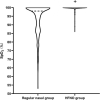High-flow nasal oxygen reduces the incidence of hypoxia in sedated hysteroscopy for assisted reproduction
- PMID: 36004375
- PMCID: PMC9394211
- DOI: 10.3389/fmed.2022.929096
High-flow nasal oxygen reduces the incidence of hypoxia in sedated hysteroscopy for assisted reproduction
Abstract
Backgrounds and aims: Pain is the main reason for hysteroscopy failure. In day-surgical settings, hysteroscopy procedures are commonly performed with the patient under sedation. Hypoxia is the most common adverse event during sedation and can lead to severe adverse events. This study aimed to compare the incidence of hypoxia when using high-flow nasal oxygen (HFNO) with that when using regular nasal oxygen in patients undergoing hysteroscopy with sedation.
Materials and methods: In this single-center, prospective, randomized, single-blinded study, 960 female patients undergoing elective diagnostic or operative hysteroscopy were randomly enrolled into the following two groups: the regular nasal group [O2 (3-6 L/min) covered by an HFNO] and the HFNO group [O2 (30-60 L/min)] from September 2021 to December 2021. All women were sedated with propofol (1.5 mg/kg) and remifentanil (1.5 μg/kg) in the operating room. The primary outcome was the incidence of hypoxia (75% ≤ SpO2 < 90%, < 60 s).
Results: HFNO decreased the incidence of hypoxia (75% ≤ SpO2 < 90%, < 60 s), subclinical respiratory depression (90% ≤ SpO2 < 95%) and severe hypoxia (SpO2 < 75% for any duration or 75% ≤ SpO2 < 90% for ≥ 60 s) from 24.38 to 0.83%, from 11.25 to 1.46% and from 3.75 to 0%, respectively (P < 0.001).
Conclusion: In procedures conducted to treat female infertility, HFNO can reduce hypoxia during hysteroscopy in patients sedated with propofol, and it can prevent the occurrence of subclinical respiratory depression and severe hypoxia.
Keywords: deep sedation; high-flow nasal oxygen; hypoxia; hysteroscopy; in vitro fertilization; propofol.
Copyright © 2022 Tang, Huang, Chai, Zhang, Zhang, Chen, Su and Huang.
Conflict of interest statement
The authors declare that the research was conducted in the absence of any commercial or financial relationships that could be construed as a potential conflict of interest.
Figures




Similar articles
-
Efficacy of high-flow nasal oxygen in preventing hypoxia during Gastrointestinal endoscopy: a retrospective cohort study.BMC Anesthesiol. 2025 Jun 3;25(1):287. doi: 10.1186/s12871-025-03155-2. BMC Anesthesiol. 2025. PMID: 40461980 Free PMC article.
-
High-flow nasal cannula oxygen therapy and hypoxia during gastroscopy with propofol sedation: a randomized multicenter clinical trial.Gastrointest Endosc. 2019 Oct;90(4):591-601. doi: 10.1016/j.gie.2019.06.033. Epub 2019 Jul 3. Gastrointest Endosc. 2019. PMID: 31278907 Clinical Trial.
-
High-Flow Nasal Oxygen versus Conventional Nasal Cannula in Preventing Hypoxemia in Elderly Patients Undergoing Gastroscopy with Sedation: A Randomized Controlled Trial.Int J Med Sci. 2024 Mar 25;21(5):914-920. doi: 10.7150/ijms.91607. eCollection 2024. Int J Med Sci. 2024. PMID: 38617012 Free PMC article. Clinical Trial.
-
Efficacy of high flow nasal oxygenation against hypoxemia in sedated patients receiving gastrointestinal endoscopic procedures: A systematic review and meta-analysis.J Clin Anesth. 2022 May;77:110651. doi: 10.1016/j.jclinane.2022.110651. Epub 2022 Jan 12. J Clin Anesth. 2022. PMID: 35030538
-
High-flow nasal oxygenation during gastrointestinal endoscopy. Systematic review and meta-analysis.BJA Open. 2022 Oct 18;4:100098. doi: 10.1016/j.bjao.2022.100098. eCollection 2022 Dec. BJA Open. 2022. PMID: 37588780 Free PMC article. Review.
Cited by
-
Efficacy of high-flow nasal oxygen in preventing hypoxia during Gastrointestinal endoscopy: a retrospective cohort study.BMC Anesthesiol. 2025 Jun 3;25(1):287. doi: 10.1186/s12871-025-03155-2. BMC Anesthesiol. 2025. PMID: 40461980 Free PMC article.
-
The Current Situation of Anaesthesia for Hysteroscopy in Mainland China: A National Survey.J Pers Med. 2023 Sep 26;13(10):1436. doi: 10.3390/jpm13101436. J Pers Med. 2023. PMID: 37888047 Free PMC article.
References
LinkOut - more resources
Full Text Sources

